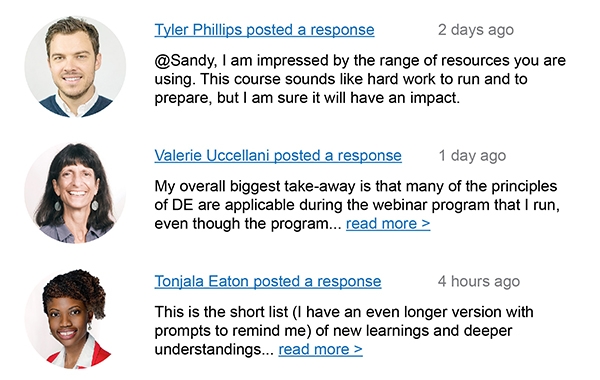Dec 13, 2023

Respect. Safety. Engagement. Inclusion. Relevance. Immediacy. These six core principles drive our work at Global Learning Partners (GLP). The other day I admitted to my colleagues that these principles sometimes feel “old-fashioned” to me. Especially in a world with so much “virtual” dialogue, I wondered if these principles were still at the heart of a solid learning experience.
To help me examine my own question, I took a look at the extent to which these core principles were operating during my own experience in an e-facilitation course with Anouk Janssens-Bervernage Dynamind eLearning. I quickly discovered that, yes indeed, these core principles are as responsible for the success of a virtual learning experience today as they were for my old Peace Corps trainings in 1988. They serve us well as a checklist for designing and facilitating, whether in-person or at-a-distance.
Respect
Acknowledge and affirm who I am and what I bring.
Learning is risky for adults, and they need to feel respected in order to take that risk. Facilitators demonstrate respect when they: acknowledge and use the wealth of experience and knowledge that adults bring to a learning environment, affirm that the adult learners are the key decision-makers in their own learning process, and present content in ways that invite critical analysis, input, and ideas for personal application.
There are endless ways to affirm participants’ uniqueness in a virtual setting.
- Communicate clearly, up front, the frame and style of the course. For example, in the software used for the e-learning platform, we could see the entire course design from the start of the course.
- Give people reasonable expectations. For example, we were told early on that the course would require nearly daily log-ins, for up to an hour each day.
- Explain your choices. Anouk, the facilitator, decided not to have any “live” component in our e-learning course because of the multitude of time zones. She explained the decision and fielded questions about it as needed.
- Show respect through your “look.” The course site had a clean, concise, professional look. It seemed to say “I respect you and want to look good for you.”
Immediacy
How soon will I get a chance to DO this?
Immediacy is all about creating opportunities for learners to DO what they are learning. Right here. Right now. And so it was in this virtual course. We were learning to be superb e-facilitators. So, the principle of immediacy demanded that we be given a chance to hone our e-facilitation skills during the course. We were given a set of very realistic scenarios and were called to respond as we would in “real life” to each one. We had to stretch ourselves to do what we thought was right, and explain the rationale for our choices in our teams. That’s immediacy!
Here are several ways to ensure immediacy:
- Ask participants to visualize and describe when and where they will apply it in the near future – “How do you see yourself using this in the next week?”
- Invite them to create action plans to put the new skill into practice.
- State early on that they will use this learning on a case study later in the day, so that learners know they will be applying it very shortly.
Relevance
How useful will this be for me?
Relevance is about aligning a learning experience with the needs and wants of those participating, however diverse. In a virtual setting we are often faced with quite a range of interests and realities, so it becomes important to know something about the participants beforehand, and to design the course to be useful in their context. For example, in this virtual course, the readings were widely applicable: for both asynchronous and synchronous environments; for those working in North America and Southern Africa; and for seasoned facilitators as well as the less-experienced.
Here are several ways to ensure relevance:
- Discover what your learners want and need BEFORE the event. Invite their input.
- Use stories and examples related to their context.
- Invite them to personalize the content. Ask them to relate it to their work and life.
- Avoid creating sessions where the content will be relevant for only a few.
- They have a right to ask the question: Why should I devote my precious time to learning your subject?
Safety
Will my view and experience be affirmed here?
Adults will not learn if the environment feels threatening. The perception of threat can trigger physiological changes in the brain that reduce its capacity for deep thinking. The atmosphere in the room, the design of learning tasks, the way dialogue is structured and facilitated should create a sense of safety, so that adults can take increasing levels of risk with their learning.
What does safety look like in a course in which people log on when they want to, and yet depend on each other’s input regularly? What does safety look like in a course in which anyone can send a public message at any time, to anyone, on any topic?
Here are several ways to create safety:
- Set the expectation of safety by laying out clear guidelines, from the start, about how people are expected to communicate with each other. For example, simple reminders like “no CAPS to show emotion,” and no harsh words.
- Invite a leader for team tasks (so that they can organize, encourage, and affirm comments).
- Assign small groups to exchange ideas and debate among themselves.
- Assure participants that “this is a safe place” by modeling safe dialogue, in writing. For example, when I went quiet for a few days, Anouk sent me a private email, gently inquiring if all was okay, rather than asking publicly WHERE THE bleep WAS I!?
Engagement
If I’m not fully engaged, I’m not learning.
How many of us have been to e-learning opportunities that had the ‘e-’ but not the ‘learning’? How can we design e-learning courses to engage everyone? Adults learn when they are fully and actively engaged in the process of learning, not when they are passive recipients of someone else’s learning. This active engagement involves their intellect, their feelings, and their physical actions.
Here are some ways I saw it happen:
- Communicate well in advance of the first day of the event to help everyone get ready (i.e. date in calendar, time set aside, log-in information handy);
- Create an opening exercise that is “gently” personal, and that everyone can do equally well – no matter who or where they are. (For example, we were asked to sit back and take a look out our closest window, then describe what we see. It makes the online environment feel much more personal, a collection of private spaces into which we’re allowed entry).
- Don’t oversimplify. The most engaging aspect of the course, by far, was the reality of the final team task. Even though the tasks involved an imaginary scenario, I knew that the scenario had grown out of real life experience. It wasn’t artificial or “manipulated” to convince me of anything. There was lots of room for disagreement and there was not one, right answer. It was complex, just like the real world!
Inclusion
Hear my voice!
Adults need to feel included in the learning process, to see that their perspective matters, and to trust that their voice is invited and heard. Facilitators must be sensitive to how the dynamics of gender, age, physical ability, education, culture, religion, ethnicity and community position (e.g. power) influence participation in any given event. They should watch for the balance of voices and perspectives raised in the group and design/facilitate in ways that intentionally draw on the varied expertise and experience in the room.

Yes, Anouk used our names to make us feel included. Yes, our photos were up on the site (if we wanted). Yes, there was sincere affirmation of our posts.
All this helped us feel included. But more than anything else what really got me – and kept me – feeling included in this e-course was freedom.
- I was free to get on the site as often as I was able.
- I was free to be a part of the dialogue in any way I chose (e.g., discussion forum, team task, e-café).
- I was free to read as much or as little as I felt inclined to.
- I was free to disagree with what others had said, and to add to it.
In other words, I felt included because, although participation was compulsory, there was room for me to participate as I felt fit. Might this explain the very high completion rates for e-workshops compared to typical e-courses?
Valerie Uccellani is a Co-Owner and Senior Partner at GLP. Anouk Janssens-Bevernage is a Co-Founder of DynaMind eLearning
Read more blogs by Valerie.
Here are other GLP blogs you may be interested in:
- Three Tips to Invite Engagement During a Webinar
- Courage and Bravery in Addition to Safety and Respect
- 5 Ways to Create Tough and Engaging Online Team Tasks
This blog was originally published on July 9, 2013.



